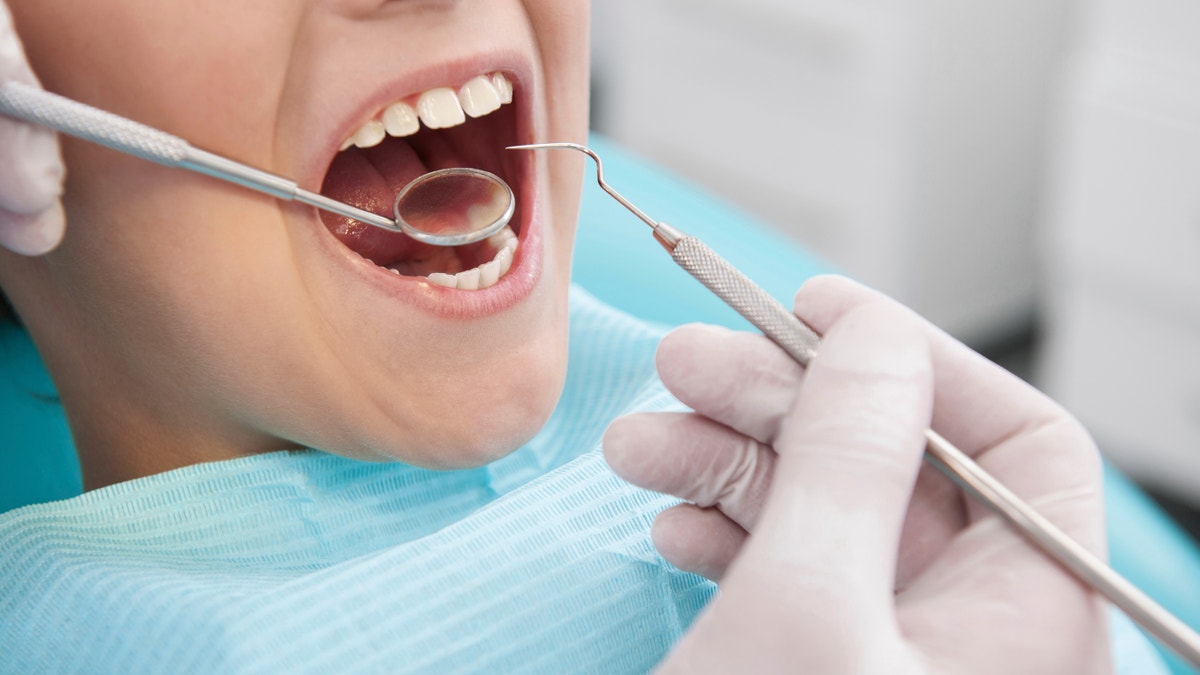
Little boy sitting at the chair at the dental office while doctor examining teeth (iStock)
When she was just 11 months old, Billie Sue Wozniak’s daughter Juno was diagnosed with type 1 diabetes, an autoimmune disease that affects 1.25 million people and approximately 200,000 children under age 20 in the United States.
The disease had affected several members of Billie Sue’s family, including her uncle, who passed away at the age of 30.
“My first thought was, ‘Her life is going to be short,’” the 38-year-old from Reno, Nevada recalled. “The more that I learned, the more I found that many people with type 1 live longer and the treatment advances are really exciting.”
While looking for treatments, Wozniak learned about encapsulation therapy, in which an encapsulated device containing insulin-producing islet cells derived from stem cells is implanted under the skin. The encapsulation device is designed to protect the cells from an autoimmune attack and may help people produce their own insulin.
After learning of the therapy through JDRF, Wozniak saw an ad on Facebook for Store-A-Tooth, a company that offers dental stem cell banking. She decided to move forward with the stem cell banking, just in case the encapsulation device became an option for Juno.
In March 2016, a dentist extracted four of Juno’s teeth, and sent them to a lab so her stem cells could be cryopreserved. Wozniak plans to bank the stem cells from Juno’s molars as well.
“It’s a risk—I don’t know for sure if it will work out,” Wozniak said.
Dental stem cells: a future of possibilities
For years, stem cells from umbilical cord blood and bone marrow have been used to treat blood and bone marrow diseases, blood cancers and metabolic and immune disorders.
Although there is the potential for dental stem cells to be used in the same way, researchers are only beginning to delve into the possibilities.
“Dental stem cells are not science fiction,” said Dr. Jade Miller, president of the American Academy of Pediatric Dentistry. “I think at some point in time, we’re going to see dental stem cells used by dentists…on a daily practice.”
Dental stem cells have the potential to produce dental tissue, bone, cartilage and muscle. They may be used to repair cavities, fix a tooth damaged from periodontal disease or bone loss, or even grow a tooth instead of using dental implants.
In fact, stem cells can be used to repair cracks in teeth and cavities, according to a recent mouse study published in the journal Scientific Reports.
There’s also some evidence that dental stem cells can produce nerve tissue, which might eliminate the need for root canals. A recent study out of Tufts University found that a collagen-based biomaterial used to deliver stem cells to the inside of damaged teeth can regenerate dental pulp-like tissues.
Dental stem cells may even be able to treat neurological disorders, spinal cord and traumatic brain injuries.
“I believe those are the kinds of applications that will be the first uses of these cells,” said Dr. Peter Verlander, Chief Scientific Officer for Store-A-Tooth.
When it comes to treating diseases like type 1 diabetes, dental stem cells also show promise. In fact, a study in the Journal of Dental Research found that dental stem cells were able to form islet-like aggregates that produce insulin.
Unlike umbilical cord blood where there’s one chance to collect stem cells, dental stem cells can be collected from several teeth. Also, gathering stem cells from bone marrow requires invasive surgery and risk, and it can be painful and costly.
The stem cells found in baby teeth, known as mesenchymal cells, are similar to those found in other parts of the body, but not identical.
“There are differences in these cells, depending on where they come from,” Verlander said.
What’s more, mesenchymal stem cells themselves differ from hematopoietic, or blood-forming stem cells. Unlike hematopoietic stem cells, mesenchymal stem cells can expand.
“From one tooth, we expect to generate hundreds of billions of cells,” Verlander said.
Yet the use of dental stem cells is not without risks. For example, there’s evidence that tumors can develop when stem cells are transplanted. There’s also a chance of an immune rejection, but this is less likely if a person uses his own stem cells, Miller said.
The process for banking stem cells from baby teeth is relatively simple. A dentist extracts the child’s teeth when one-third of the root remains and the stem cells are still viable. Once the teeth are shipped and received, the cells are extracted, grown and cryopreserved.
Store-A-Tooth’s fees include a one-time payment of $1,749 and $120 per year for storage, in addition to the dentist’s fees for extraction.
For families who are interested in banking dental stem cells, they should know that they’re not necessarily a replacement for cord blood banking or bone marrow stem cells.
“They’re not interchangeable, we think of them as complementary,” Verlander said.
Although the future is unclear for Juno—who was born in 2008—her mom is optimistic that she’ll be able to use the stem cells for herself and if not, someone else.
Ultimately, however, Wozniak hopes that if dental stem cells aren’t the answer, there will be a biological cure for type 1 diabetes.
“I hold out hope that somewhere, someone is going to crack the code,” she said.
